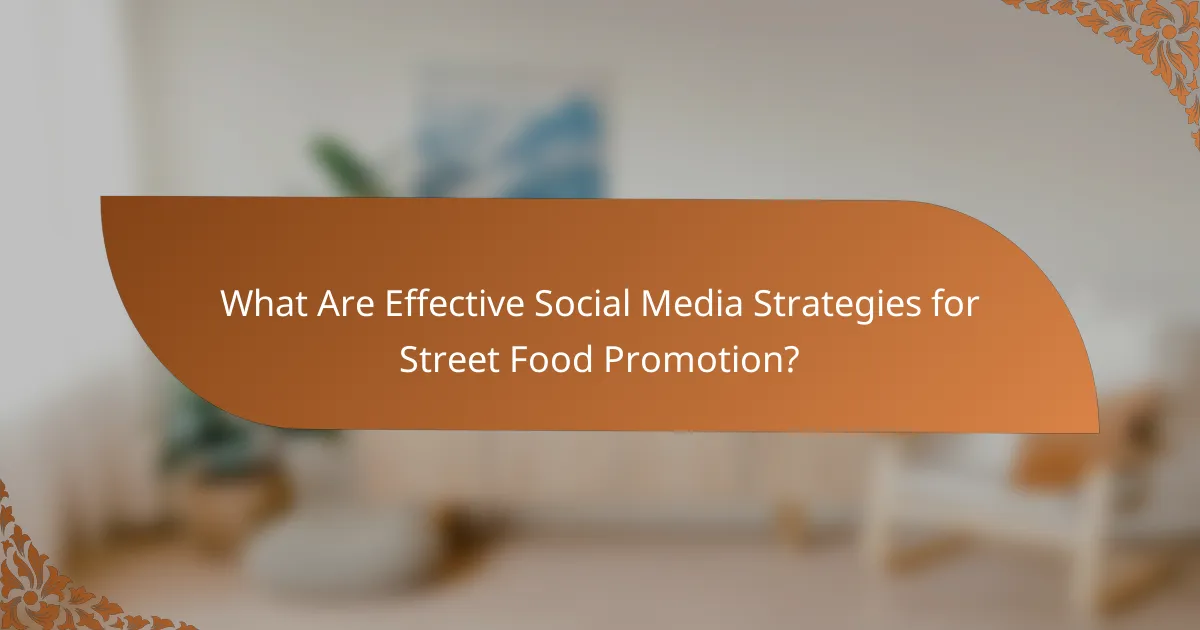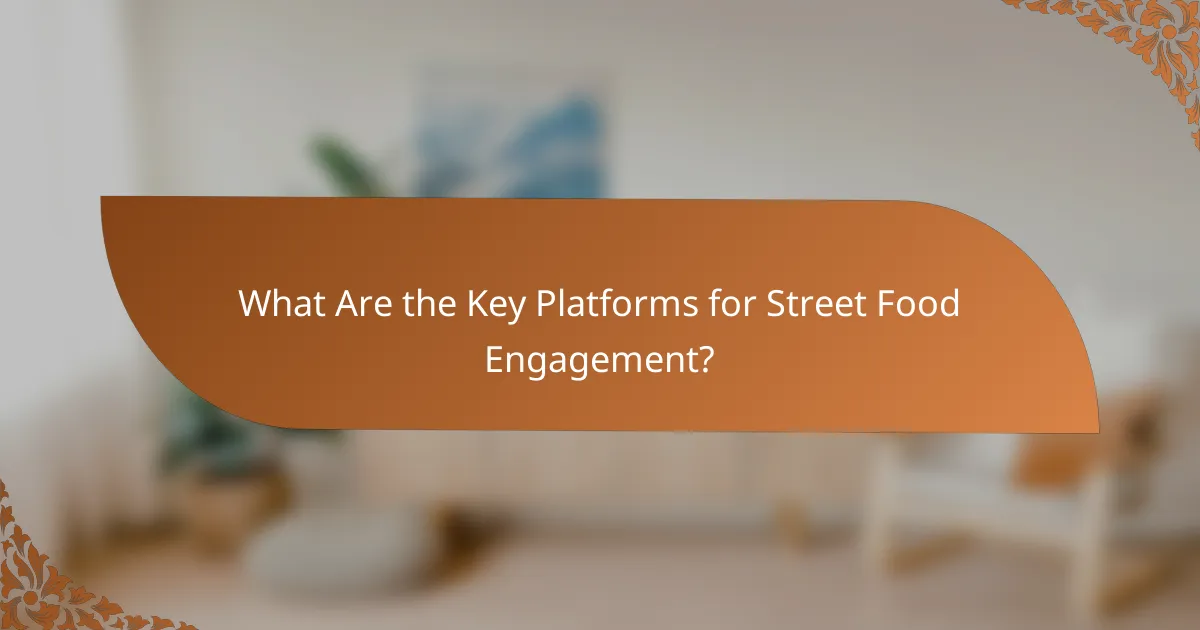Social media plays a crucial role in shaping street food trends by increasing vendor visibility and enabling real-time customer engagement. Platforms like Instagram and TikTok allow street food businesses to showcase their unique offerings while directly interacting with their audience, which significantly influences popularity. By leveraging effective promotional strategies and analyzing customer insights, vendors can refine their menus and marketing efforts to align with consumer preferences.

How Does Social Media Influence Street Food Trends?
Social media significantly shapes street food trends by enhancing visibility for vendors, facilitating real-time customer feedback, and amplifying trends through shares. Platforms like Instagram and TikTok allow street food businesses to showcase their offerings and engage directly with customers, influencing what becomes popular.
Increased visibility for vendors
Social media provides street food vendors with a platform to reach a broader audience without the need for traditional advertising. By posting appealing images and videos of their dishes, vendors can attract customers who may not have discovered them otherwise.
Using location tags and relevant hashtags can further enhance visibility, making it easier for potential customers to find vendors nearby. For example, a food truck in Berlin can use hashtags like #BerlinEats or #StreetFoodBerlin to connect with local food enthusiasts.
Real-time customer feedback
Social media allows vendors to receive immediate feedback from customers, which can be invaluable for improving offerings. Comments and reviews on posts can highlight what customers enjoy or suggest changes, enabling vendors to adapt quickly to preferences.
Engaging with feedback not only helps improve the food but also builds a loyal customer base. Vendors who respond to comments and messages create a sense of community, encouraging repeat visits and word-of-mouth promotion.
Trend amplification through shares
When customers share their experiences on social media, they amplify trends and introduce new dishes to a wider audience. A single post featuring a unique street food item can go viral, leading to increased foot traffic for the vendor.
To maximize this effect, vendors should encourage customers to tag them in their posts and use specific hashtags. Offering incentives, such as discounts for sharing photos, can motivate customers to promote the vendor’s brand, further enhancing visibility and trend adoption.

What Are Effective Social Media Strategies for Street Food Promotion?
Effective social media strategies for street food promotion involve creating engaging content, leveraging influencer partnerships, and implementing targeted advertising campaigns. These approaches help street food vendors connect with their audience, enhance visibility, and drive customer engagement.
Engaging content creation
Creating engaging content is crucial for attracting attention to street food offerings. This can include high-quality images and videos showcasing food preparation, customer experiences, and unique menu items. Using storytelling techniques to share the background of the food or the vendor can also enhance emotional connections with potential customers.
Consider using formats like live cooking demonstrations or behind-the-scenes footage to create a sense of authenticity. Regularly posting updates about new menu items or special events can keep your audience engaged and encourage repeat visits.
Utilizing influencer partnerships
Partnering with local influencers can significantly amplify your street food promotion efforts. Influencers with a strong following in the food niche can introduce your offerings to a broader audience, providing authentic endorsements that resonate with their followers. Choose influencers whose values align with your brand for the best results.
When collaborating, provide influencers with unique experiences, such as exclusive tastings or special events, to create compelling content. Track engagement metrics from these partnerships to assess their impact on your visibility and sales.
Targeted advertising campaigns
Implementing targeted advertising campaigns on platforms like Facebook and Instagram can effectively reach potential customers interested in street food. Use demographic and geographic targeting to ensure your ads are seen by individuals likely to visit your location, such as local food enthusiasts or tourists.
Consider allocating a budget for promotions that highlight special offers or events. Monitor the performance of your ads and adjust your strategy based on engagement rates and conversion metrics to optimize your spending.

How Can Street Food Vendors Leverage Customer Insights from Social Media?
Street food vendors can effectively use customer insights from social media to enhance their offerings and engage with their audience. By analyzing interactions and feedback, vendors can tailor their menus and marketing strategies to better meet customer preferences.
Analyzing customer preferences
Understanding customer preferences is crucial for street food vendors looking to succeed. Social media platforms provide valuable data on what dishes are trending, which can guide menu adjustments. For instance, if a particular taco recipe garners significant attention, vendors might consider featuring it more prominently.
Vendors can utilize tools like polls or surveys on platforms such as Instagram or Facebook to directly ask customers about their favorite flavors or dishes. This direct engagement can yield insights that are more specific than general observations.
Identifying peak engagement times
Knowing when customers are most active on social media can help street food vendors time their promotions effectively. Engagement typically peaks during lunch hours and evenings, but this can vary by location and audience. Vendors should analyze their own social media metrics to determine the best times to post updates or promotions.
Using scheduling tools can help vendors plan posts for these peak times, ensuring maximum visibility. Additionally, vendors should consider local events or festivals that might influence engagement patterns.
Gathering feedback for menu development
Feedback collected from social media is invaluable for menu development. Vendors can monitor comments and reviews to identify which dishes customers love or dislike. This information allows for informed decisions about which items to keep, modify, or remove from the menu.
Encouraging customers to leave feedback through social media contests or incentives can further enhance this process. For example, offering a discount for sharing a review can increase engagement and provide more data for menu refinement.

What Are the Key Platforms for Street Food Engagement?
The key platforms for street food engagement include Instagram, Facebook, and Twitter, each serving unique purposes in promoting street food trends and connecting with customers. These platforms facilitate visual storytelling, community building, and real-time updates, making them essential for street food vendors looking to enhance their presence.
Instagram for visual storytelling
Instagram is a powerful tool for street food vendors to showcase their offerings through high-quality images and videos. Engaging visuals can attract customers and create a strong brand identity, making it crucial to post regularly and use relevant hashtags.
Consider sharing behind-the-scenes content, such as food preparation or vendor stories, to deepen customer connections. Aim for a consistent aesthetic that reflects your brand, as this can significantly enhance engagement rates.
Facebook for community building
Facebook excels in fostering community among street food enthusiasts and vendors. Creating a dedicated page or group allows for direct interaction with customers, sharing updates, and gathering feedback.
Utilize Facebook Events to promote food festivals or special offerings, encouraging local engagement. Regularly post polls or questions to involve your audience, which can help in understanding customer preferences and improving service.
Twitter for real-time updates
Twitter is ideal for providing real-time updates about menu changes, location shifts, or special promotions. Its fast-paced nature allows vendors to communicate directly with customers, enhancing engagement through timely interactions.
Use Twitter to share quick updates, respond to customer inquiries, and join relevant conversations in the food community. Regularly posting can keep your audience informed and engaged, increasing foot traffic to your food stall or truck.

How Do Trends Emerge on Social Media for Street Food?
Trends in street food often emerge through social media platforms where users share experiences, photos, and recommendations. These trends can quickly gain traction, influencing consumer preferences and vendor offerings.
Viral challenges and hashtags
Viral challenges and hashtags play a significant role in amplifying street food trends. When users participate in challenges, they create a sense of community and engagement around specific food items, encouraging others to join in. For example, a hashtag like #TacoTuesday can lead to increased sales for taco vendors as people share their culinary adventures.
To leverage this, street food vendors should create unique hashtags for their offerings and encourage customers to share their experiences online. This not only boosts visibility but also fosters a loyal customer base that actively promotes the brand.
Seasonal promotions and events
Seasonal promotions and events can significantly influence street food trends by aligning offerings with holidays or local festivities. For instance, food trucks may introduce pumpkin-flavored items during fall or special dishes for local festivals, attracting attention and driving foot traffic.
Vendors should plan their promotional calendar around local events and seasonal trends to maximize engagement. Offering limited-time items can create urgency, prompting customers to try new dishes while they are available.
Collaboration with food bloggers
Collaborating with food bloggers can effectively elevate a street food vendor’s profile and reach. Food bloggers often have dedicated followings that trust their recommendations, making them valuable partners for promoting new menu items or special events.
To make the most of these collaborations, vendors should seek out bloggers whose audiences align with their target market. Offering complimentary meals or exclusive previews can incentivize bloggers to share their experiences, generating authentic content that resonates with potential customers.

What Metrics Should Vendors Track for Social Media Success?
Vendors should focus on engagement rates, follower growth, and conversion metrics to gauge social media success. These metrics provide insights into how well content resonates with the audience and how effectively it drives sales.
Engagement Rates
Engagement rates reflect how actively users interact with a vendor’s posts, including likes, shares, comments, and saves. A higher engagement rate indicates that the content is resonating well with the audience. Vendors should aim for engagement rates in the range of 1-5% for effective outreach.
To improve engagement, vendors can create interactive content such as polls, questions, or contests. Regularly responding to comments and messages also fosters a sense of community and encourages further interaction.
Follower Growth
Follower growth measures how quickly a vendor’s audience is expanding on social media platforms. This metric is crucial for building brand awareness and reaching new customers. A steady growth rate of 5-10% monthly is often considered healthy.
To boost follower growth, vendors should promote their social media accounts through in-person interactions, such as on food trucks or at events, and collaborate with local influencers. Consistent posting and high-quality content can also attract new followers.
Conversion Metrics
Conversion metrics track how many social media interactions lead to actual sales or desired actions, such as signing up for a newsletter. This metric helps vendors understand the effectiveness of their promotional efforts. A conversion rate of 1-3% is typical for social media campaigns.
To enhance conversion rates, vendors should include clear calls to action in their posts and link directly to their ordering platforms. Utilizing promotional offers or discounts exclusive to social media followers can also incentivize purchases.
